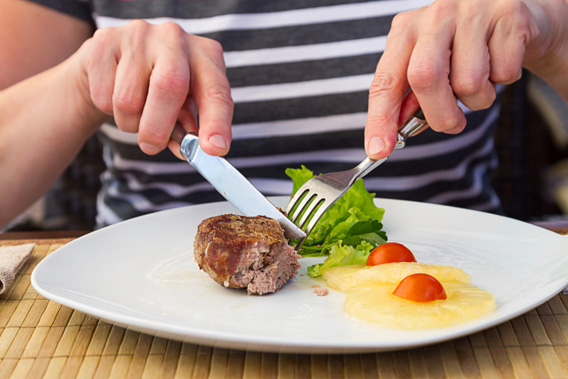 Does your fork switch hands after cutting?
Does your fork switch hands after cutting?Photo by Yury Minaev/iStockphoto/Thinkstock
You have nice table manners. For an American.
A European businessman once paid me that backhanded compliment at a dinner in London. If only I?d had the presence of mind to chomp a few dinner rolls into a doughy mess before turning to reply, wide-eyed and slack-jawed, ?Pffffardon me? Fwwwahat did you say?? Instead, I asked what I?d done to deserve such ?praise.?
Turns out I don?t zig-zag. Fffwhat?s that? Zig-zag is etiquette doyenne Emily Post?s term for it, but we could also call it the Star-Spangled Fork-Flip, the Freedom Fork-Over, or the Homeland Handoff. Or the cut-and-switch. See, when using both a fork and knife, Europeans (and everyone else, basically) will keep the fork in their left hand and the knife in the right as they cut and eat their food. But the traditionally well-mannered American? After he cuts a piece of amber-waves-of-grain-fed steak, he?ll lower his knife to his plate. And then he?ll switch the fork (USA! USA!) to his right hand to convey the food.
Do you cut-and-switch? Well, you?ve got to stop. The more time you waste pointlessly handing utensils back and forth to yourself, the less time you?ll have to cherish life and liberty, pursue happiness, and contribute to America?s future greatness. And also?though that snob at dinner surely didn?t know this?the supposedly all-American cut-and-switch is in fact an old European pretension, of just the sort we decided to free ourselves from 237 years ago.
Yup. The cut-and-switch is originally European. According to Darra Goldstein, a professor at Williams College and the founding editor of Gastronomica: The Journal of Food and Culture, when forks first came to the European dining table, diners took their cues from the kitchen, where the fork would be held in the left hand to steady a slab of meat, say, and the right hand wielded the knife. So far, so good. But around the early 18th century, particularly in France, it became fashionable for diners to put the knife down after cutting, and swap the fork to the right hand?i.e., to cut-and-switch.
What explains the rise of the cut-and-switch? One theory: Fancy manners often fetishize delicacy, and it?s just easier to delicately convey food to your mouth with your dominant hand. Anna Post, Emily?s great-great-granddaughter, passed along another possibility. Back when dinnertime violence was a not too distant cultural memory, lowering the knife?even a rounded one?was intuitively associated with high manners. Indeed Goldstein describes how American fork-floppers lay the knife on their plate?blade facing in?as a ?medieval position of trust.?
The cut-and-switch could also reflect garden-variety prejudice against the left hand. Even today, in much of the Arab world, the right hand alone is used for eating (traditionally without utensils), while the left is relegated to a less exalted realm of daily responsibilities. Nor should we underestimate the possibility that the cut-and-switch became popular precisely because it was cumbersome. Harry Mount, the author of How England Made the English, reminded me how often, in the contrary world of manners, ?greater inefficiency can infer greater elegance.?
Nineteenth-century Americans acquired the cut-and-switch from France??the arbiter of elegance? for Americans then, says Goldstein. But by then Europe was already changing. In 1853, a French text claimed it was trendy to not cut-and-switch. Again, there may be no good reason. Bethanne Patrick, author of An Uncommon History of Common Courtesy, told me she suspects convenience and efficiency eventually won out, hastening the adoption of the no-switch style we now call Continental or European?and then that, too, took on the force of fashion.
What is clear is that America never got the telegram. The cut-and-switch?like imperial units of measurement?counts among those European castaways that became Americanisms only when Europe itself changed. Today, the cut-and-switch is the equivalent of a mouthful of glittering white teeth, a calf-ful of glittering white sock, or a request for half-and-half?an absolute clincher that you stand in the company of a fellow lover of freedom. Jeanette Martin, the co-author of Global Business Etiquette, couldn?t think of another major country that fork-swaps. Even among Canadians, some zig-zag, but ?Continental predominates.?
Well. We?ve had our fun. And now it?s time to stop. Americans prize efficiency?especially when it comes to food. Sure, a cut-and-switch partisan might argue that Americans already eat fast enough?whether we?re talking about actual fast food, practically predigested squeezable pouches and energy bars, or our enthusiastic and all but unique embrace of eating while walking and driving; you could argue that the cut-and-switch is just the kind of gastronomic speed bump we need more of. But what if we spend so little time at the table because we find fork-swapping so tedious?
flight tracker Marina Krim Justin Bieber cancer Mockingbird Lane peyton manning sf giants gold rush
No comments:
Post a Comment
Note: Only a member of this blog may post a comment.